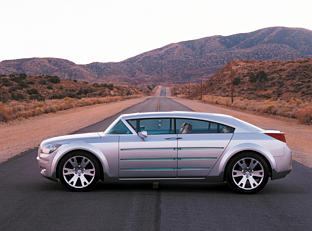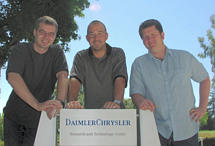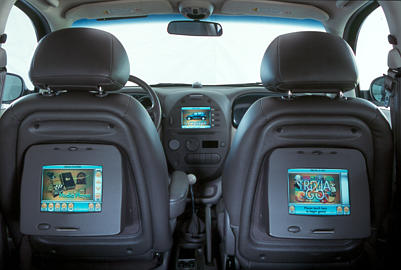ELJonline: Behind the Wheel with Linux
Sep 1, 2001 — by LinuxDevices Staff — from the LinuxDevices Archive — viewsThe terms “driver” and “engine” take on new (or rather old) meanings (and Linux becomes a lot more “robust”) when you throw a Hemi in the mix.
First introduced at the North American International Auto Show in Detroit in January 2001, the Dodge Super8 concept car is one that demands comment. With its controversial design, 353ci Hemi motor (the number of cubes is equal to the number of horsepower–exceeded only by its 395 lbs.-ft. of torque) and four on-board Linux systems offering multimedia entertainment, GPS and network connectivity, you can't avoid having an opinion and voicing it.
 Despite its space-age “Infotronic system”, initially the car is more striking for its retroactivity than its modernity. It screams 1950s with its suicide doors, steep windshield and dinosaur pushrod American iron (the size of the `50s Hemi engines rather than the famed 426s of the 1960s), but instead of looking like a finned rocket, it just has the navigational and entertainment systems of one.
Despite its space-age “Infotronic system”, initially the car is more striking for its retroactivity than its modernity. It screams 1950s with its suicide doors, steep windshield and dinosaur pushrod American iron (the size of the `50s Hemi engines rather than the famed 426s of the 1960s), but instead of looking like a finned rocket, it just has the navigational and entertainment systems of one.
Though DaimlerChrysler chose the in-your-face, super-powered, retro, all-American Super8 as the showcase for this cornucopia of technology (coincidence?), the Infotronic system found here had humbler beginnings in the form of the IT Cruiser, a high-tech version of the PT Cruiser (another highly retro design). The test systems in both cars were built by the folks at the Smart Vehicles Group of the DaimlerChrysler Research and Technology North America Inc. in Palo Alto, California in collaboration with the DaimlerChrysler Liberty and Technical Affairs Division and the Chrysler Design Studio, both in Michigan. Sun Microsystems also lent a hand.
I recently spoke with Smart Vehicles Group Manager Dr. Wieland Holfelder and Senior Research Scientists John Lundberg and Thomas Bock to learn more about their efforts.

(From left to right) Smart Vehicles Group Manager Dr. Wieland Holfelder and Senior Research Scientists Thomas Bock and John Lundberg
They told me the IT Cruiser system is identical to that in the Super8, as far as hardware and software, and serves as a rolling research lab as well as an additional demonstration vehicle.
The computer systems in both cars combine Jini, Java and Linux into four SBCs that provide an in-vehicle information/entertainment system. The system includes games and music via media beaming through a wireless LAN connecting to the home entertainment system in order to synchronize files in the car; multiple home network (as in the capability to connect to multiple homes) for connectivity to sprinkler systems, alarm, lights, etc.; a global positioning system (GPS); web browsing and e-mail.
As someone who feels the average driver has enough distractions (what with pretending to drive while talking on the phone, applying make-up, reading novels and chastising children), my first impression was, “Now we'll get to deal with typing drivers as well.” But a lot of effort has gone into making the system safe. The car is divided into four vehicle zones: driver, front passenger and left- and right-rear passenger. Web browsing is available only in the rear cabin (maybe the Super8 will outsell Lincoln Town Cars as the chauffeured car of choice). E-mail in the front, and indeed the entire user interface, is voice-activated using speech recognition and text-to-speech technologies based on the Java Speech Application Programming Interface. A wireless keyboard and voice control is also provided for rear passengers. Array microphones are used in all seats to filter background and road noise from commands and to separate the commands from each zone.
 Each SBC runs a Java Virtual Machine on top of Linux. One provides access to the GPS and to the engine controller and vehicle bus system. The other three provide the user interface for various zones in the car. In the front zone is a 6.4″ LCD, the two in back measure 8.4″ and are touchscreens. A Java Card (a smart card with a Java-enabled chip) is used to identify the user and personalize the given zone accordingly.
Each SBC runs a Java Virtual Machine on top of Linux. One provides access to the GPS and to the engine controller and vehicle bus system. The other three provide the user interface for various zones in the car. In the front zone is a 6.4″ LCD, the two in back measure 8.4″ and are touchscreens. A Java Card (a smart card with a Java-enabled chip) is used to identify the user and personalize the given zone accordingly.
On the topic of safety, Dr. Holfelder remarked:
Safety engineering itself is one of the biggest concerns for DaimlerChrysler and is always a top priority when introducing new electrical/electronic features. The Infotronic system installed in the IT Cruiser and the Dodge Super8 Hemi concept car is a prototype. If such a system were ever to enter production it would be designed to meet the strict safety requirements of DaimlerChrysler after undergoing extensive human-machine interface testing.
As far as the chances of the Infotronic system making it into production, the Smart Vehicles Research Group was quick to confess that that's not their department, but that all aspects of production were certainly taken into account during design. Dr. Holfelder points out that the system is a “research rather than a development project”. He says, “Our aim was to showcase the benefits of an open platform for telematics applications and services that might be introduced in future vehicles. On the way we utilized what we felt were the best components for achieving this goal (such as the use of Linux).”
As to the choice of Linux, John Lundberg explains that, for their purposes, it was the stablest operating system they could use and that others yielded less stable results. Also, their specific needs require the flexibility that Linux offers. By way of example he explains, “We have a very unique network setup for connection to our on-board network, to a wireless local network such as your home network and a wide area network to the Internet. This setup would pose more problems with another OS and might not even be possible.”
A stripped-down version of Red Hat 6.2 was chosen for development purposes since there were not significant constraints on the hardware side, but the large numbers that go with actual production (and the associated costs) would likely induce hardware constraints that would lead to the use of a certified embedded Linux such as Hard Hat.
The team's belief in open standards was revealed in their answer to the question: “How do you trade entertainment media from home to car if the media at home is in a proprietary format that employs constraints like DRM (digital rights management) to restrict the user's ability to copy? You don't.” Proprietary formats will need to be converted to an open standard.
Currently the 802.11, CDPD and Ricochet wireless standards are supported, but potentially, all standards can be supported provided the service includes an IP interface. Dr. Holfelder mentions that they “have an abstract communication layer in the communication gateway that hides the details of a particular wireless standard from the applications.”
I asked about the degree of access granted to the driver (the person behind the wheel) to the engine controller by the gateway SBC, and Thomas Bock replied, “In principle we as an OEM have full access to the vehicle bus system and engine controllers. Since we also control the in-vehicle system and software platform, we can decide how much we want to open that up for such things as third-party applications.”
If the Super8 actually sees production, it may prove to be the perfect tool for unification of Linux geeks and muscle car gearheads. And the guilt associated with the resource-devouring engine will be assuaged with the knowledge that the entertainment keeping the kiddies quiet is running open-source software.
 About the author: Richard Vernon is editor in chief of Linux Journal.
About the author: Richard Vernon is editor in chief of Linux Journal.
Copyright © 2001 Specialized Systems Consultants, Inc. All rights reserved. Embedded Linux Journal Online is a cooperative project of Embedded Linux Journal and LinuxDevices.com.
This article was originally published on LinuxDevices.com and has been donated to the open source community by QuinStreet Inc. Please visit LinuxToday.com for up-to-date news and articles about Linux and open source.